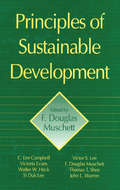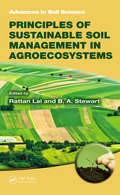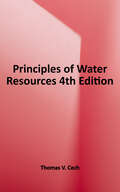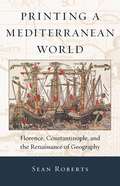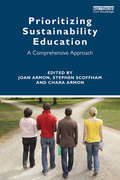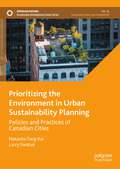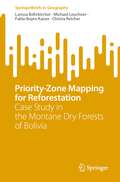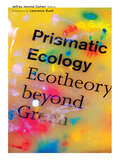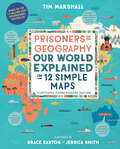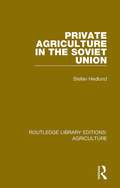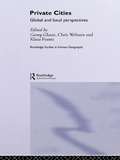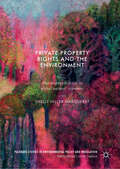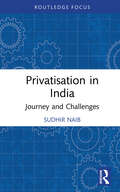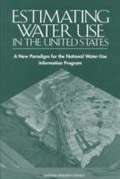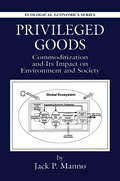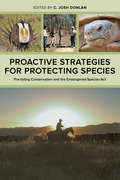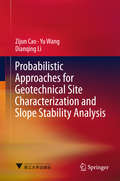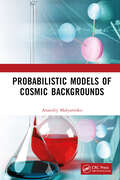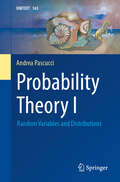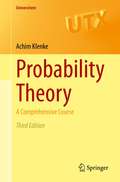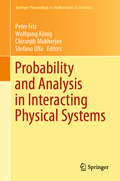- Table View
- List View
Principles of Sustainable Development
by F. Douglas MuschettThis book brings together the collective thinking, ecological perspectives, and experiences of individuals from air quality, land use and transportation disciplines who are working to advance and operationalize sustainable development.
Principles of Sustainable Soil Management in Agroecosystems (ISSN)
by Rattan Lal B. A. StewartWith the use of high-level soil management technology, Africa could feed several billion people, yet food production has generally stagnated since the 1960s. No matter how powerful the seed technology, the seedling emerging from it can flourish only in a healthy soil. Accordingly, crop yields in Africa, South Asia, and the Caribbean could be double
Principles of Tidal Sedimentology
by Richard A. Davis Jr. Robert W. DalrympleThis book presents a comprehensive, contemporary review of tidal environments and deposits. Individual chapters, each written by world-class experts, cover the full spectrum of coastal, shallow-marine and even deep-marine settings where tidal action influences or controls sediment movement and deposition. Both siliciclastic and carbonate deposits are covered. Various chapters examine the dynamics of sediment transport by tides, and the morphodynamics of tidal systems. Several chapters explore the occurrence of tidal deposits in the stratigraphic context of entire sedimentary basins. This book is essential reading for both coastal geologists and managers, and geologists interested in extracting hydrocarbons from complex tidal successions.
Principles of Water Resources: History, Development, Management, and Policy
by Thomas V. CechProper management of water resources can take many forms, and requires the knowledge and expertise to work at the intersection of mathematics, geology, biology, geography, meteorology, political science, and even psychology. <p><p>This book provides an essential foundation in water management and development concepts and practices, dissecting complex topics into short, understandable explanations that spark true interest in the field. Approaching the study of water resources systematically, the discussion begins with historical perspective before moving on to physical processes, engineering, water chemistry, government regulation, environmental issues, global conflict, and more. <p><p>Now in its fourth edition, this text provides the most current introduction to a field that is becoming ever more critical as climate change begins to threaten water supplies around the world. As geography, climate, population growth, and technology collide, effective resource management must include a comprehensive understanding of how these forces intermingle and come to life in the water so critical to us all.
Printing a Mediterranean World: Florence, Constantinople, and the Renaissance of Geography
by Sean RobertsIn 1482 Francesco Berlinghieri produced the Geographia, a book of over 100 folio leaves describing the world in Italian verse interleaved with lavishly engraved maps. Roberts demonstrates that the Geographia represents the moment of transition between printing and manuscript culture, while forming a critical base for the rise of modern cartography.
Prioritizing Sustainability Education: A Comprehensive Approach
by Stephen Scoffham Joan Armon Chara ArmonPrioritizing Sustainability Education presents theory-to-practice essays and case studies by educators from six countries who elucidate dynamic approaches to sustainability education. Too often, students graduate with exploitative, consumer-driven orientations toward ecosystems and are unprepared to confront the urgent challenges presented by environmental degradation. Educators are prioritizing sustainability-oriented courses and programs that cultivate students’ knowledge, skills, and values and contextualize them within relational connections to local and global ecosystems. Little has yet been written, however, about the comprehensive sustainability education that educators are currently designing and implementing, often across or at the edges of disciplinary boundaries. The approaches described in this book expand beyond conventional emphases on developing students’ attitudes, knowledge, and behaviors by thinking and talking about ecosystems to additionally engaging students with ecosystems in sensory, affective, psychological, and cognitive dimensions, as well as imaginative, spiritual, or existential dimensions that guide environmental care and regeneration. This book supports educators and graduate and upper-level undergraduate students in the humanities, social sciences, environmental studies, environmental sciences, and professional programs in considering how to reorient their fields toward relational sustainability perspectives and practices.
Prioritizing the Environment in Urban Sustainability Planning: Policies and Practices of Canadian Cities (Sustainable Development Goals Series)
by Larry Swatuk Natasha Tang KaiThis book examines the extent to which the environment is addressed in the sustainability plans of Canadian cities. It assesses if and to what extent select leading environmental priorities are addressed in the sustainability plans of sixteen Canadian cities, followed by analysis of efforts towards each priority. It scores and ranks cities against each environmental priority and highlights what makes some cities lead and others lag in environmental sustainability.The book unravels the complexity, similarities, and differences in environmental sustainability planning across major cities in Canada. The project reflects what’s working, who’s leading, and which environmental priorities support the sustainable city model. Climate change has exacerbated the impacts of flood, droughts, wildfire and storms, urban centers must account for sustainability to mitigate and adapt to a changing and uncertain landscape. It begins with robust and integrative sustainability plans that prioritize the environment. This book will make a timely contribution to the on-going debate regarding the ways and means to become a sustainable city. It reflects the on-going sustainable development discourse and deliberations to meet the Sustainable Development Goals. It cut across many SDGs in particular SDG 11, Sustainable Cities and Communities. What makes this study unique is its special attention to environmental priorities within urban sustainability planning. This subject is topical and would appeal to both scholars and practitioners at local, regional, national, and global scales.
Priority-Zone Mapping for Reforestation: Case Study in the Montane Dry Forests of Bolivia (SpringerBriefs in Geography)
by Christa Reicher Michael Leuchner Larissa Böhrkircher Fabio Bayro KaiserAndean dry forest ecosystems are threatened by deforestation and unsustainable land use methods. The negative effects for the livelihood of the local population, biodiversity, and the regional climate could be countered by reforestation measures; however, dry land forests have not attracted the same level of interest and investment like other ecosystems. This book describes the development of a priority-zone map for reforestation measures, showing where reforestation might have the greatest social and ecological benefits. To achieve this, a problem analysis of a case study region is conducted and thematic reforestation benefits are determined. Using remote sensing and GIS, the areas where benefits can be obtained are mapped in individual layers and compiled into a summarizing priority-zone map. It is thus possible to identify areas where reforestation would achieve multiple benefits. The concept of priority maps could be used to facilitate reforestation strategies by local communities and municipal governments and could thus contribute to initiate an integrated forest and landscape restoration of the Bolivian montane dry forests.
Prismatic Ecology: Ecotheory beyond Green
by Jeffrey Jerome CohenEmphasizing sustainability, balance, and the natural, green dominates our thinking about ecology like no other color. What about the catastrophic, the disruptive, the inaccessible, and the excessive? What of the ocean&’s turbulence, the fecundity of excrement, the solitude of an iceberg, multihued contaminations? Prismatic Ecology moves beyond the accustomed green readings of ecotheory and maps a colorful world of ecological possibility.In a series of linked essays that span place, time, and discipline, Jeffrey Jerome Cohen brings together writers who illustrate the vibrant worlds formed by colors. Organized by the structure of a prism, each chapter explores the coming into existence of nonanthropocentric ecologies. &“Red&” engages sites of animal violence, apocalyptic emergence, and activism; &“Maroon&” follows the aurora borealis to the far North and beholds in its shimmering alternative modes of world composition; &“Chartreuse&” is a meditation on postsustainability and possibility within sublime excess; &“Grey&” is the color of the undead; &“Ultraviolet&” is a potentially lethal force that opens vistas beyond humanly known nature.Featuring established and emerging scholars from varying disciplines, this volume presents a collaborative imagining of what a more-than-green ecology offers. While highlighting critical approaches not yet common within ecotheory, the contributions remain diverse and cover a range of topics including materiality, the inhuman, and the agency of objects. By way of color, Cohen guides readers through a reflection of an essentially complex and disordered universe and demonstrates the spectrum as an unfinishable totality, always in excess of what a human perceives.Contributors: Stacy Alaimo, U of Texas at Arlington; Levi R. Bryant, Collin College; Lowell Duckert, West Virginia U; Graham Harman, American U in Cairo; Bernd Herzogenrath, Goethe U of Frankfurt; Serenella Iovino, U of Turin, Italy; Eileen A. Joy; Robert McRuer, George Washington U; Tobias Menely, Miami U; Steve Mentz, St. John&’s U, New York City; Timothy Morton, Rice U; Vin Nardizzi, U of British Columbia; Serpil Oppermann, Hacettepe U, Ankara; Margaret Ronda, Rutgers U; Will Stockton, Clemson U; Allan Stoekl, Penn State U; Ben Woodard; Julian Yates, U of Delaware.
Prisoners of Geography: Our World Explained In 12 Simple Maps (illustrated Young Readers Edition) (Politics Of Place Ser. #1)
by Tim Marshall“For curious children ages 7–15, Prisoners of Geography has lots to fascinate.”—The Wall Street Journal The secret world history written in the mountains, rivers, and seas that shape every country’s politics, economy, and international relations—and our own lives—is revealed in this illustrated young readers edition of Prisoners of Geography, the million-copy international bestseller. History is a story—and it’s impossible to tell the whole tale without understanding the setting. In this eye-opening illustrated edition of the international bestseller Prisoners of Geography, you’ll learn to spot connections between geography and world affairs in ways you never noticed before. How did the US’s rivers help it become a superpower? Why are harsh, cold and swampy Siberia and the Russian Far East two of that country’s most prized regions? How come Japan prefers to trade along the coasts instead of across its land? What do the Himalayas have to do with war? With colorful maps that capture every continent and region, plus hundreds of illustrations that illuminate how our surroundings shape us, this one-of-a-kind atlas will inspire curious minds of all ages!
Prithvi Hamara Avas class 6 - NCERT - 23: पृथ्वी हमारा आवास ६वीं कक्षा - एनसीईआरटी - २३
by Rashtriy Shaikshik Anusandhan Aur Prashikshan Parishadपृथ्वी हमारा आवास 6वीं कक्षा का राष्ट्रीय शैक्षिक अनुसंधान और प्रशिक्षण परिषद् ने पुस्तक हिंदी भाषा में प्रकाशित किया गया है, इस पाठ्यपुस्तक में छह अध्याय दिए है। पाठ्यपुस्तक में सौरमंडल में पृथ्वी, ग्लोब: अक्षांश एवं देशांतर, पृथ्वी की गतियाँ, मानचित्र, पृथ्वी के प्रमुख परिमंडल और हमारा देश: भारत आदी के विषय पर चर्चा की गई है।
Private Agriculture in the Soviet Union (Routledge Library Editions: Agriculture #15)
by Stefan HedlundFirst published in 1989. Perestroika, it was widely believed, must succeed in agriculture before permanent change could be affected elsewhere in the Soviet economy. But Soviet agriculture had so far remained stubbornly inefficient and resistant to change. In this book Stefan Hedlund investigates the reasons for this state of affairs. The author gives an account of the emergence, development and performance of private agriculture in the Soviet Union. In particular he describes the essentials of the peculiarly Soviet hybrid of private and socialized agriculture. He places the private sector within the broader framework of Soviet agriculture. He saw Soviet agriculture as a ‘Black Hole’, ready to absorb any resources that came near, be they private plots, urban gardens, factory workshops or military units. Hedlund also examines the impact on the peasants as producers of decades of negative ideological pronouncements in Party propaganda, and of discrimination and at times outright harassment by local officials. He points out that this background makes the prospect of any positive response from the peasants to Gorbachev’s call for perestroika in agriculture extremely unlikely.
Private Cities: Global and Local Perspectives (Routledge Studies in Human Geography #Vol. 13)
by Chris Webster Georg Glasze Klaus FrantzFor the antagonist, private communities are icons of post-consensus, fragmenting civic society, enclosing and excluding by contractual constitution and sometimes by walls and gates. For others they are simply an efficient new way of organizing urban life. Contributed to, and edited by, an international team of leading authors, this revealing book constructs an interdisciplinary discourse on the global spread of private communities based upon empirical evidence. Case studies from the US, Latin America, the Middle East, Europe and China are used to explore local and global explanations of the phenomenon. Taking an institutionalist approach, this informative textbook for undergraduates, postgraduates, and researchers alike, develops a model in which cities are shaped by the interplay of local and global processes, and evolve at the interface of spontaneous and planned order. It draws together the various themes, propositions and hypotheses in a way that clarifies the questions by different social science perspectives and that poses researchable questions and new agendas.
Private Property Rights and the Environment: Our Responsibilities to Global Natural Resources (Palgrave Studies in Environmental Policy and Regulation)
by Shelly Hiller MargueratThis book explores the current notion and definition of property, and its interpretation and implementation in relation to the environment. The author examines two primary problems: the degradation of land, natural resources and animal abuse; and the increasing erosion of private property rights from property owners by the arbitrary interference of state governments. Examining texts from antiquity to contemporary legislation, it portrays the historical development of the understanding of “nature” as “property” and discusses our obligations towards the environment. Drawing on the most influential political-philosophical texts from all periods of property rights history, the author analyzes modern national and international legislation and case law to offer legally-grounded evidence and explanations. This book advocates the incorporation of a formula that guarantees the protection of property rights into the legal system, and imposes clear and effective responsibility on property owners to limit the use of natural resources and the abuse of animals. This book will appeal to practitioners, researchers and students with an interest in environmental and private property law.
Private Regulation of Labor Standards in Global Supply Chains: Problems, Progress, and Prospects
by Sarosh KuruvillaPrivate Regulation of Labor Standards in Global Supply Chains examines the effectiveness of corporate social responsibility on improving labor standards in global supply chains.Sarosh Kuruvilla charts the development and effectiveness of corporate codes of conduct to ameliorate "sweatshop" conditions in global supply chains. This form of private voluntary regulation, spearheaded by Nike and Reebok, became necessary given the inability of third world countries to enforce their own laws and the absence of a global regulatory system for labor standards. Although private regulation programs have been adopted by other companies in many different industries, we know relatively little regarding the effectiveness of these programs because companies don't disclose information about their efforts and outcomes in regulating labor conditions in their supply chains.Private Regulation of Labor Standards in Global Supply Chains presents data from companies, multi-stakeholder institutions, and auditing firms in a comprehensive, investigative dive into the world of private voluntary regulation of labor conditions. The picture he paints is wholistic and raw, but it considers several ways in which this private voluntary system can be improved to improve the lives of workers in global supply chains.
Privatisation in India: Journey and Challenges (Routledge Focus on Business and Management)
by Sudhir NaibThis book is a comprehensive work which incisively analyses, from a theoretically informed perspective, crucial aspects of India’s journey from partial divestiture to privatisation, accompanied by case studies of enterprises being privatised in FY 2022. Naib begins with the economic role of the state followed by theoretical and empirical evidence on the state versus private ownership in the first two chapters. Next, an overview of public sector in India including the New Public Sector Enterprise Policy for Atmanirbhar Bharat-2021 is discussed, before a broader examination of the global experience with privatisation is done. Naib then goes on to explore India’s journey from partial divestiture to privatisation from 1991 to 2021 in four time slots based on the political party in power. The book also looks at big ticket privatisation and asset monetisation proposed in FY 2022. Many criticised the design of National Monetisation Plan as it may lead to concentration of wealth, increasing inequalities, asset stripping, and consumers paying higher charges. The book closes by presenting six instances of big-ticket privatisations ranging from airlines, airports, banks, insurance, as well as industries such as petroleum and telecoms. The book’s timely data and analysis of key developments will interest researchers in the fields of divestiture and privatisation in India.
Privatization of Water Services in the United States: An Assessment of Issues and Experience
by Committee on Privatization of Water Services in the United StatesIn the quest to reduce costs and improve the efficiency of water and wastewater services, many communities in the United States are exploring the potential advantages of privatization of those services. Unlike other utility services, local governments have generally assumed responsibility for providing water services. Privatization of such services can include the outright sale of system assets, or various forms of public-private partnerships—from the simple provision of supplies and services, to private design construction and operation of treatment plants and distribution systems. Many factors are contributing to the growing interest in the privatization of water services. Higher operating costs, more stringent federal water quality and waste effluent standards, greater customer demands for quality and reliability, and an aging water delivery and wastewater collection and treatment infrastructure are all challenging municipalities that may be short of funds or technical capabilities. For municipalities with limited capacities to meet these challenges, privatization can be a viable alternative.Privatization of Water Services evaluates the fiscal and policy implications of privatization, scenarios in which privatization works best, and the efficiencies that may be gained by contracting with private water utilities.
Privileged Goods: Commoditization and Its Impact on Environment and Society
by Jack P. MannoWhat are the obstacles in the way of effectively solving the environmental crises of our time? What can we do to overcome them? These may be two of the most important questions heading into the 21st century. Organized human societies have the ability to completely change the world. While we have excelled at building, destroying and rebuilding, we h
Proactive Strategies for Protecting Species
by C. Josh DonlanNearly forty years old, the Endangered Species Act (ESA) remains a landmark act in conservation and one of the world’s most comprehensive laws designed to prevent species extinctions and support recovery efforts for imperiled species. A controversial law and often subject to political attack, the ESA is successful overall but not without difficulties. Those who enforce the ESA, for example, struggle to achieve viable recovery goals for many species. At the forefront of challenges is a reactive framework that sometimes leads to perverse incentives and legal battles that strain support and resources. Further, few species have been delisted. Proactive Strategies for Protecting Species explores the perspectives, opportunities, and challenges around designing and implementing pre-listing programs and approaches to species conservation. This volume brings together conservation biologists, economists, private and government stakeholders, and others to create a legal, scientific, sociological, financial, and technological foundation for designing solutions that incentivize conservation action for hundreds of at-risk species-prior to their potential listing under the ESA. This forward-thinking, innovative volume provides a roadmap for designing species conservation programs on the ground so they are effective and take place upstream of regulation, which will contribute to a reduction in lawsuits and other expenses that arise after a species is listed. Proactive Strategies for Species Protection is a guidebook for anyone anywhere interested in designing programs that incentivize environmental stewardship and species conservation.
Probabilistic Approaches for Geotechnical Site Characterization and Slope Stability Analysis
by Yu Wang Zijun Cao Dianqing LiThis is the first book to revisit geotechnical site characterization from a probabilistic point of view and provide rational tools to probabilistically characterize geotechnical properties and underground stratigraphy using limited information obtained from a specific site. This book not only provides new probabilistic approaches for geotechnical site characterization and slope stability analysis, but also tackles the difficulties in practical implementation of these approaches. In addition, this book also develops efficient Monte Carlo simulation approaches for slope stability analysis and implements these approaches in a commonly available spreadsheet environment. These approaches and the software package are readily available to geotechnical practitioners and alleviate them from reliability computational algorithms. The readers will find useful information for a non-specialist to determine project-specific statistics of geotechnical properties and to perform probabilistic analysis of slope stability.
Probabilistic Models of Cosmic Backgrounds
by Anatoliy MalyarenkoCombining research methods from various areas of mathematics and physics, Probabilistic Models of Cosmic Backgrounds describes the isotropic random sections of certain fiber bundles and their applications to creating rigorous mathematical models of both discovered and hypothetical cosmic backgrounds.Previously scattered and hard-to-find mathematical and physical theories have been assembled from numerous textbooks, monographs, and research papers, and explained from different or even unexpected points of view. This consists of both classical and newly discovered results necessary for understanding a sophisticated problem of modelling cosmic backgrounds.The book contains a comprehensive description of mathematical and physical aspects of cosmic backgrounds with a clear focus on examples and explicit calculations. Its reader will bridge the gap of misunderstanding between the specialists in various theoretical and applied areas who speak different scientific languages.The audience of the book consists of scholars, students, and professional researchers. A scholar will find basic material for starting their own research. A student will use the book as supplementary material for various courses and modules. A professional mathematician will find a description of several physical phenomena at the rigorous mathematical level. A professional physicist will discover mathematical foundations for well-known physical theories.
Probability Theory I: Random Variables and Distributions (UNITEXT #165)
by Andrea PascucciThis book provides a concise yet rigorous introduction to probability theory. Among the possible approaches to the subject, the most modern approach based on measure theory has been chosen: although it requires a higher degree of mathematical abstraction and sophistication, it is essential to provide the foundations for the study of more advanced topics such as stochastic processes, stochastic differential calculus and statistical inference. The text originated from the teaching experience in probability and applied mathematics courses within the mathematics degree program at the University of Bologna; it is suitable for second- or third-year students in mathematics, physics, or other natural sciences, assuming multidimensional differential and integral calculus as a prerequisite. The four chapters cover the following topics: measures and probability spaces; random variables; sequences of random variables and limit theorems; and expectation and conditional distribution. The text includes a collection of solved exercises.
Probability Theory: A Comprehensive Course (Universitext)
by Achim KlenkeThis popular textbook, now in a revised and expanded third edition, presents a comprehensive course in modern probability theory.Probability plays an increasingly important role not only in mathematics, but also in physics, biology, finance and computer science, helping to understand phenomena such as magnetism, genetic diversity and market volatility, and also to construct efficient algorithms. Starting with the very basics, this textbook covers a wide variety of topics in probability, including many not usually found in introductory books, such as: limit theorems for sums of random variables martingales percolation Markov chains and electrical networks construction of stochastic processes Poisson point process and infinite divisibility large deviation principles and statistical physics Brownian motion stochastic integrals and stochastic differential equations. The presentation is self-contained and mathematically rigorous, with the material on probability theory interspersed with chapters on measure theory to better illustrate the power of abstract concepts.This third edition has been carefully extended and includes new features, such as concise summaries at the end of each section and additional questions to encourage self-reflection, as well as updates to the figures and computer simulations. With a wealth of examples and more than 290 exercises, as well as biographical details of key mathematicians, it will be of use to students and researchers in mathematics, statistics, physics, computer science, economics and biology.
Probability and Analysis in Interacting Physical Systems: In Honor of S.R.S. Varadhan, Berlin, August, 2016 (Springer Proceedings in Mathematics & Statistics #283)
by Wolfgang König Stefano Olla Peter Friz Chiranjib MukherjeeThis Festschrift on the occasion of the 75th birthday of S.R.S. Varadhan, one of the most influential researchers in probability of the last fifty years, grew out of a workshop held at the Technical University of Berlin, 15–19 August, 2016. This volume contains ten research articles authored by several of Varadhan's former PhD students or close collaborators. The topics of the contributions are more or less closely linked with some of Varadhan's deepest interests over the decades: large deviations, Markov processes, interacting particle systems, motions in random media and homogenization, reaction-diffusion equations, and directed last-passage percolation. The articles present original research on some of the most discussed current questions at the boundary between analysis and probability, with an impact on understanding phenomena in physics. This collection will be of great value to researchers with an interest in models of probability-based statistical mechanics.
Probability and Statistics for Particle Physics
by Carlos MañaThis book comprehensively presents the basic concepts of probability and Bayesian inference with sufficient generality to make them applicable to current problems in scientific research. The first chapter provides the fundamentals of probability theory that are essential for the analysis of random phenomena. The second chapter includes a full and pragmatic review of the Bayesian methods that constitute a natural and coherent framework with enough freedom to analyze all the information available from experimental data in a conceptually simple manner. The third chapter presents the basic Monte Carlo techniques used in scientific research, allowing a large variety of problems to be handled difficult to tackle by other procedures. The author also introduces a basic algorithm, which enables readers to simulate samples from simple distribution, and describes useful cases for researchers in particle physics.The final chapter is devoted to the basic ideas of Information Theory, which are important in the Bayesian methodology. This highly readable book is appropriate for graduate-level courses, while at the same time being useful for scientific researches in general and for physicists in particular since most of the examples are from the field of Particle Physics.
